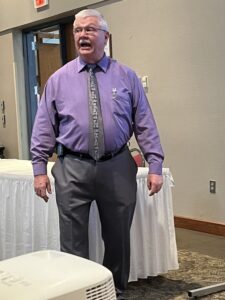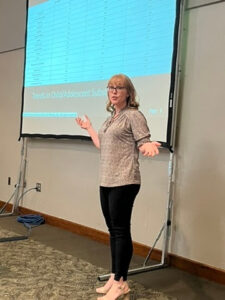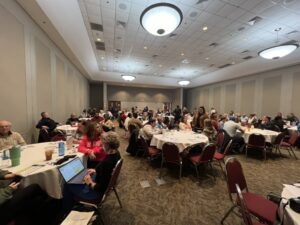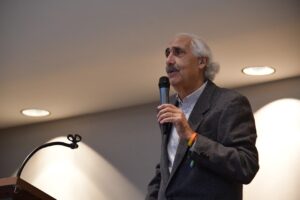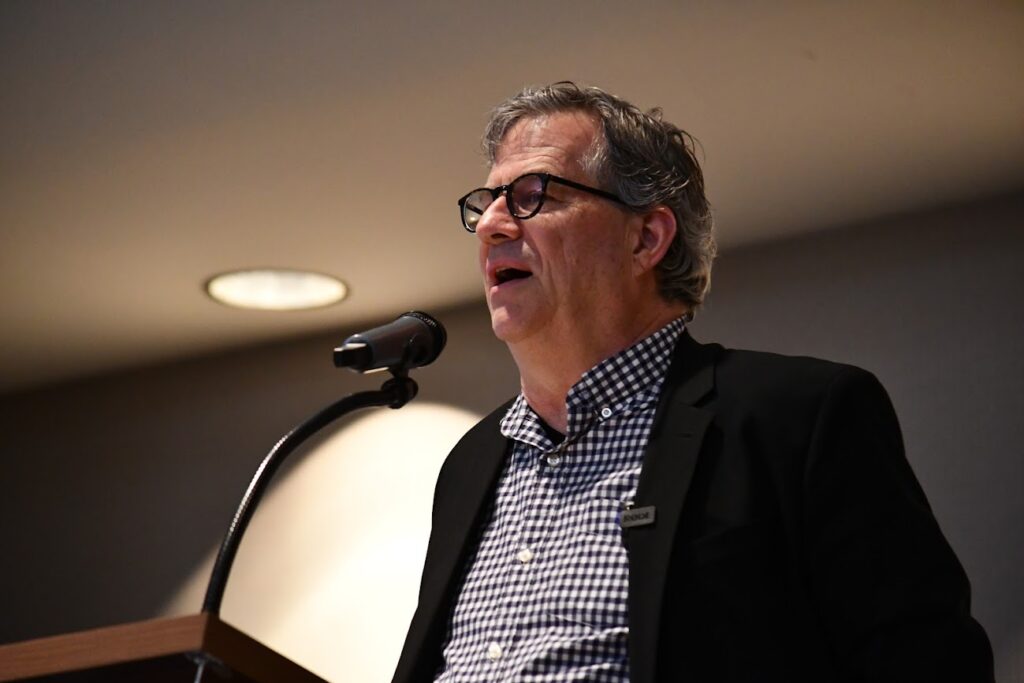
BY DEBBIE PAGE
Drug-Alcohol Coalition of Iredell Board Chair Dorothy Hensley asked community members some sobering questions on Monday as she welcomed them to the “In The Know” event’s “day of learning, listening, and experiencing” issues surrounding substance misuse.
“As parents, do we know what our child is exposed to? Do we know what our child is seeing at school? Do we know what they’re doing after school? Do we know how bad the opioid problem is? Do we know where to get someone help? Do we know how to flatten the line of substance misuse that keeps getting greater each year?
“We are looking to challenge each and every one of you to get out of your comfort zone and ask questions and take action.”
Statesville Mayor Costi Kutteh thanked attendees for coming to learn more and for their passion for drug and alcohol awareness and treatment, born for some from personal experiences with loved ones’ struggles.
DACI Executive Director Shane Nixon said a coalition’s power is “when ‘we’ do what ‘I’ can’t. A coalition is when all of us get involved when one of us won’t make a difference.”
The DACI coalition’s mission is to “flatten the line” of substance misuse and overdose in Iredell County.
When Nixon became joined DACI two years ago, the coalition surveyed middle schoolers, finding that one in three had vaped in the last 30 days. After anti-vaping education efforts, a recent DACI survey indicated that number fell to one in four.
Though that seems like a small decrease, Nixon said, “Find that fourth parent and ask him or her if it made a difference because I assure it does.”
DACI has passed out thousands of prescription lock boxes and drug disposal kits to keep dangerous drugs out of the hands of others, particularly youths.
DACI Program Coordinator Kristin Blumenstein noted the importance of parents locking up dangerous drugs. “Sixty-six percent of young people abusing prescription medications and overdosing died at home.”
The nonprofit is also partnering with the county’s law enforcement agencies to buy an incinerator to destroy prescription and OTC drugs collected in DACI drop boxes and those confiscated by law enforcement officers.
If the people of Iredell County get “In The Know,” substance use problems will begin to solve themselves. “If we don’t flatten the line, it might be somebody you love,” said Nixon.
QUINONES KEYNOTE
Keynote speaker and New York Times bestselling author and journalist Sam Quinones said that as he was writing his book “Dreamland: The True Tale of America’s Opiate Epidemic,” he was struck by the silence of families devastated by addiction. Their shame and mortification kept them from sharing the hell that they experienced, he said.
His book sparked “a movement into the light” for drug misuse, causing him to travel the country speaking on his research and meeting Americans of every type.
Quinones said he saw a national grassroots movement emerging to fight the opioid pill and heroin epidemic at the same time that an even more sinister specter emerged on the street – powerful synthetic opioids and a vicious new form of methamphetamine.
Opioid users suddenly had access to a flood of cheap, easy-to-make fentanyl, a substance that even in the quantity of a pinpoint-size dose is deadly. The huge outpouring of synthetic opioids from Mexico, joined later by even more potent carfentanil, created even more user demand since traffickers began lacing them into marijuana, counterfeit pills, cocaine, and other illegal drugs to support the users’ quest for more intense highs.
Fentanyl’s “quick in and out” anesthetic properties are great in a controlled hospital setting, noted Quinones, but on the street users required more doses of the short-acting fentanyl to avoid brutal withdrawal symptoms.
A new “super meth” also entered the western U.S. around 2013. When authorities in Mexico cracked down on ephedrine and pseudoephedrine, used to make the “party” methamphetamine of the 1990s, illicit meth manufacturers turned to phenyl-2-propanone, known as P2P, and other cheap chemicals to make a 90 percent pure drug.
As the price of super meth dropped by 90 percent by 2020, users also flocked to P2P, which causes rapid onset schizophrenia (within hours), lack of empathy, and antisocial behavior. Quinones said P2P is a “major driver of mental illness and homelessness.”
Quinones emphasized that unlike in the past, “there is no more risk-free drug use. Anything could be laced with fentanyl.”
Getting substance users to treatment is also problematic because no time exists to hit a “rock bottom” for those who are dying from this potent drugs. Their brain function is so altered that “readiness” for treatment cannot develop.
“The drugs are highjacking their brain systems and aid in their demise” because to them, “drugs equal life,” and the survival instinct is squelched by drug cravings and avoidance of withdrawal, resulting in a slow suicide.
“There are no long-term fentanyl users — they’re dead,” the author said.
Quinones noted that the less “friction” there is to obtain these drugs, the more chances there are to become addicted. With the internet and social media providing easy access to home delivery by dealers, Quinones compares these drugs’ availability to legal substances like alcohol and tobacco.
Efforts like decriminalization, wide availability of naloxone, and voluntary treatment of the past will not be effective with these powerful drugs. Repeated overdoses, treated with naloxone, cause further brain damage that further interferes with basic decision-making to move toward treatment.
“There’s no time for their brains to rest, so they go straight back to use,” he said.
Quinones called for a proliferation of drug courts to create leverage over substance users to start and maintain treatment, with an extended period of supervision. Jails need to become places of recovery for substance users, focusing on treatment, structure, life skills, GEDS, and building overall health.
“With a rethinking of jail, we can build a continuum of care that starts with an arrest but has two to three years of drug court follow-up to help them transition back into society.”
Quinones pointed out the complexity of treating addiction since it is most often a symptom of self-medicating a mental illness or trauma. “But if we don’t get them off the streets and into treatment, they will die. They cannot find readiness on the street.”
America is “a toxic soup of legal addictive stuff,” added Quinones. Social media, gambling, fast food, soda, coffee, and ultra-processed foods loaded with sugar or high fructose corn syrup all feed the addictive tendencies present in all human brains.
“Chicken becomes chicken nuggets, coffee becomes Frappuccinos, we can gamble from home. Weed is now 30 to 40 percent THC, with vapes as much as 90 percent. There’s a constant supply of legal stuff to feed our cravings, with companies using addiction triggers to sell it.”
The best defense to all of these addictive triggers is repairing and strengthening community, according to Quinones, who believes community “is more powerful than any drug.”
“The cave man who went out on his own got eaten,” Quinones joked. He advocated for using the power of story-telling, music, sports, festivals, and neighborhood suppers to bring people back together.
“We need to re-examine our lives and work to create community connection because we are only as strong as the least of us. We’ve turned our back on small efforts and the least in our society. Small efforts matter.”
“Jesus understood the importance of community — we cannot function if we turn against each other.”
Though Quinones first thought the drug epidemic was more prevalent in low-socio economic areas, he realized as he traveled the U.S. that the epidemic exists in affluent areas like Charlotte as well.
“What is their pain in a fluent communities? Isolation? The lack of knowing each other? It’s kind of a malaise of prosperity,” he said.
Quinones believes that people do not remember how to just interact naturally. “Now we have to organize and create community events. It’s not organic. We have to bring people out of their houses and consciously plan small community and neighborhood events now.
“People want community, but they don’t know what it is or how to do it. This is part of the isolation of American prosperity, caused by smaller families and extended families being spread across the country.”
In his book “The Least of Us: True Tales of America and Hope in the Time of Fentanyl and Meth,” Quinones also looked for hope in healing the crisis. “I looked for the smallest, least noticed, non-sexy stories of Americans involved in community repair — people who knew there was no magic bullet to what ails us.”
Quinones asked attendees to take those small, unheralded steps and to change their mindsets to see recovery as a community as well as an individual effort. They can use available assets to make change. Nurturing small businesses, especially gathering places like coffee shops and cafes, are essential to help make life nice for local people.
Small businesses are the story of American resilience, in Quinones’ view. Business incubators help grow these economic engines, and community centers and swimming pools are also important gathering places.
Quinone also encourages the community to enlist the talents of recovering substance users, who are “energy raising from decay.
“Evolving and working together will create betterment for all,” he said. “We have stopped believing in what we can effect in our communities and underestimated the preciousness of us.”
“We need to reawaken ourselves, work daily to embrace life, and develop self-reliance and economic development. We are strongest in community, as weak as the most vulnerable, and the least of us lies within us all.”
ALCOHOL: THE SILENT KILLER
Jeff Eades and Gary Marshall of Partners noted in their afternoon small group session that alcohol use often sneaks up on people over time, with families often stuck in the middle of excessive alcohol use.
“All people, regardless of drinking habits, need to know somebody cares if things get out of control or if the family is affected by misuse.”
“In recovery groups, it’s not as much about what is said as it’s just being with other people. In addiction, people often lose their sense of place and community and connections,” added Eades.
Eades said excessive alcohol use is the third leading preventable cause of death in North Carolina, according to state statistics. In 2021, over 6,300 deaths occurred due to excessive alcohol use.
Excessive drinking is associated with injuries, violence, and chronic conditions like stroke, hypertension, and some cancers.
Eades acknowledged that alcohol is a powerful substance. “Even knowing that it will kill you, you still do it anyway, and the marketing is everywhere.”
Binge drinking, defined as an adult male having five drinks or a female having four over a period of two hours, is also a major issue.
“The thing that we are ingesting is inhibiting our brains from saying, ‘Too much!’”
Ninety percent of excessive drinkers are not alcohol dependent. Eades said this suggests that a large portion were engaging in excessive alcohol consumption do not meet the criteria for alcohol dependence.
“This distinction is important to remember when you look at the diverse spectrum of alcohol use.”
NC Detect data noted that the 24 to 44 age group and the 45 to 64 age group had the highest total emergency department visits because of alcohol-related incidents. Those over 65 also had a noteworthy percentage of alcohol-related cases that resulted in an emergency room visit.
Half of adults in North Carolina drink alcohol. Eleven percent classify themselves as heavy drinkers, with 29 percent saying that they binge drink, according to the 2021 North Carolina Behavioral Risk Factor Survey.
People in the 45 to 64 age group had the highest percentage of acute alcohol intoxication or poisoning cases. Underage alcohol ED visits, particularly among college students, were also noted.
In North Carolina, 19 percent of high school students say they are currently drinking alcohol. Of those high school students who drink, half binge drink, 36 percent usually drink liquor, and 43 percent usually obtained alcohol through family or friends versus buying it for themselves, according to the 2021 North Carolina Youth Risk Behavior Survey.
THE HOWS AND WHYS OF TEEN SUBSTANCE MISUSE
In another afternoon breakout session, Sadie Parson of ICGH Treatment Centers said some of the earliest influences on teens to smoke, drink alcohol, or use drugs may come from family factors, including poor self image, lack of faith-based influence, poor school performance, parental rejection, family dysfunction, abuse, controlling parents, or divorce.
Peer influence also plays a pivotal role in the initial use of tobacco and drugs. Girls seem to be more influenced by environmental factors in chaotic home conditions where there is a little emphasis on conventional family life or there are parents using drugs.
Eighth-graders who take care of themselves after school also had a significantly higher risk of using alcohol, tobacco, or marijuana. Youths living in disadvantage areas were five times more likely to be offered cocaine compared to those in more affluent areas.
Parson also shared statistics from the 2022 National Survey on Drug Use, which showed that about 169 million people people age 12 or older used tobacco products, vaped nicotine, used alcohol, or used an illicit drug in the past month, including about 137 million people who drank alcohol, 51 million who used tobacco products, nearly 24 million people who vaped nicotine, and about 47 million people who used an illicit drug.
In 2022 just over 70 million people aged 12 or older used illegal drugs in the past year. Marijuana was most used, with 62 million using it in the past year.
In 2022, nearly 49 million people age 12 or older had a substance used disorder in the past year. Almost 30 million people had alcohol use disorder, 27 million had a drug use disorder, and about 8 million had both.
Among adolescents age 12 to 17, 4.8 million had a major depressive episode. Over 1 in 8 adolescents age 12 to 17 (about 3.4 million teens) had serious thoughts of suicide in the past year.
One in fifteen (about 1.7 million youths) made suicide plans, and nearly 1 in 25 (953,000) attempted suicide in the past year.
Parson said neurobiology plays an important role in teen drug use and decision-making since brain development continues until age 25.
Healthy brain development in adolescents is crucial for proper cognitive, emotional, and social functioning. Altered brain development because of exposure to alcohol and drugs sets the stage for cognitive problems in adulthood.
Dopamine, a neurotransmitter made in the brain, plays a role as a “reward center” and assists in many body functions, including working memory, movement, motivation, mood, and attention.
When youths use drugs or alcohol, their dopamine is significantly reorganized, resulting in limited self-control and causing complications with their emotional development and their brain’s reward system.
If parents suspect drug or alcohol use, screening tools can be used to assess teenage substance misuse.
Research indicates that children with ADHD, oppositional defiant disorder, conduct disorder, and depression are at an increased risk of developing substance-related disorders as teens. However, anxiety disorders do not seem to increase the risk for future substance misuse.
These findings emphasize the need for early detection and intervention for children with these disorders to lower the possibility of substance use disorders later. Life skills training is effective to lower the use of tobacco, alcohol, and marijuana among teens.
Relapse is very fairly common among adolescents in treatment. About one-third to one-half return to using within 12 months. Consistent aftercare, treating coexisting behavior or mental disorders, fostering coping skills, careful monitoring, avoiding peer drug use, strong parental support, and encouraging motivation are important factors in treating adolescents with substance use issues.
Treatments includes mental health and substance use disorder therapies, family therapy, Eye Movement Desensitization and Reprocessing (EMDR), Trauma-Focused Cognitive Behavioral Therapy (T-F CBT), and medically assisted treatment for age-appropriate clients.
THE SCIENCE OF ADDICTION
Jesse Stroud of Southern Family Medicine presented a breakout session on the science of addiction, explaining that neurons, which act as switches that control the flow information in the brain, send signals to facilitate various body functions,
Drug use interferes with neurons sending and processing signals, resulting in abnormal messages and communication disruptions between different parts of the brain. Some drugs even mimic schizophrenia, which causes misdiagnoses in the medical world.
Alcohol and drugs affect various parts of the brain. One part, the basal ganglia, controls motivations, such as sex, socializing, eating habits and routines, and acts as a reward circuit. Substancee use overstimulates this area and produces euphoria.
After experiencing the intense drug euphoria, the person then has difficulty feeling any pleasure except from the artificial high he or she gets from the drug.
Another part of the brain, the amygdala, is where stress, anxiety, irritability and unease is located. People with withdrawal symptoms may use drugs to get temporary relief from their discomfort rather than to get high. Research has also found that marijuana use over the long-term increases anxiety and depression by affecting the amygdala.
The prefrontal cortex is the part of the brain where a person thinks, plans, solves problems, make decisions, and exerts self-control over impulses. This is the last part of the brain to mature, making teens most vulnerable to substance use damage to this area. Loss of self-control caused by substance use creates even more compulsion to take drugs.
The brain stem area, where the heartbeat, breathing, and sleeping are regulated, is very much affected by opioids, which cause depressed breathing.
Over time, the brain develops tolerance to the drug being abused. If a person achieves recovery and relapses at the previous dose, an overdose is more likely. Previously incarcerated people find the most dangerous time for overdose after release is in the first seven to 10 days when they reuse the previous dose after a long period of sobriety..
Stroud said that scientists still are trying to understand how the pleasure or euphoria from the drug high works in the brain. They do believe it probably involves surges of chemical-signaling compounds, including the body’s natural opioids called endorphins, and other neurons affecting the reward circuit.
The drugs cause great surges of these neurotransmitters, much larger than the smaller bursts naturally produced with healthy rewards like eating, listening to music, creative pursuits or social interaction.
Scientists once thought that dopamine surges caused euphoria, but now they think dopamine has more to do with people wanting to repeat pleasurable activities rather than producing the pleasure directly.
Large surges of dopamine teach the brain to seek drugs at the expense other healthier goals and activities.
Cues in a persons daily routine and environment have also become linked with drug use relapse because of the changes to the reward circuit that trigger uncontrollable cravings whenever the person is exposed to the cues, even if the drug is not available.
Stroud said this learned reflex can last a long time, even in people who have not used drugs in many years. For example, people who have been drug-free for a decade can experience cravings when returning to a neighborhood or house where they used drugs. Like riding a bike, the brain remembers.
Even though drugs do cause physiological harm, the brain can heal much of the damage through neuroplasticity, the lifelong capacity of the brain to change and rewire itself, but healing takes effort.
Because of the excessively high amount of dopamine produced when a person is using drugs, a person in recovery has to work to keep their happiness and gratitude level high to keep their dopamine level elevated.
Participating in recovery groups, making connections and staying engaged are the biggest agents of change for people in recovery. Emotional-based therapy group can help many people who are learning to feel emotions again without drugs’ euphoric high.
Stroud ended the session by emphasizing the complexity of substance use’s effect on brain function. “It really is a disease, and we need to reduce the stigma and treat it like any other disease to try to help the people that have fallen into this cycle of misuse.”
Other breakout sessions offered to community members were the Hidden in Plain Sight teen bedroom project by Regina Propost of Insight Human Services, prevention and harm reduction by Jessica Miller of the Iredell County Health Department, and the facts about vaping by Carlene Crawford, Region 4 tobacco control manager for NC Tobacco-Free Alliance.
PHOTOS

